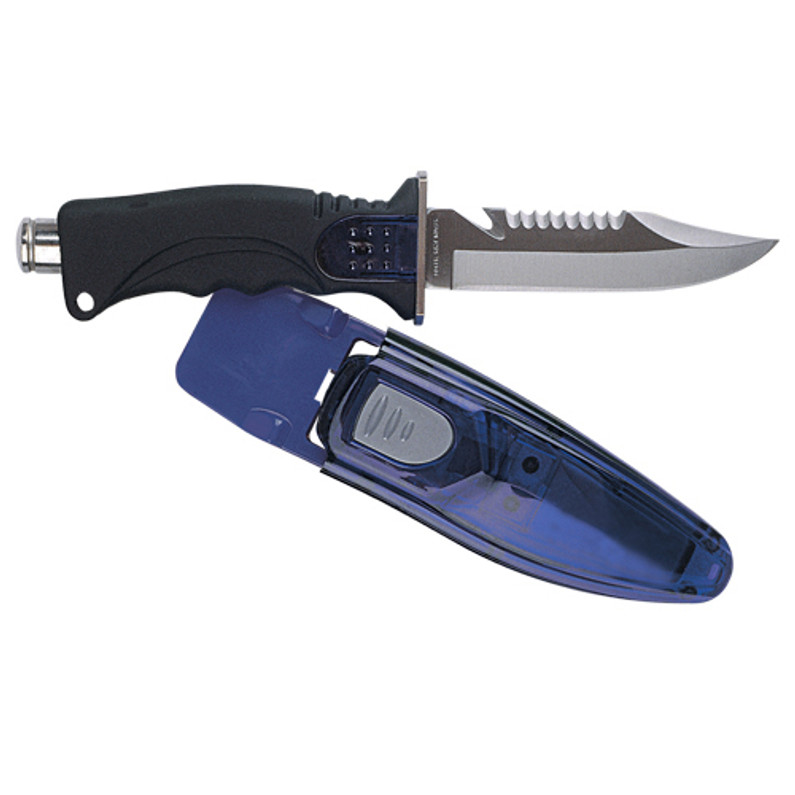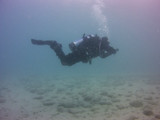Dive Knives and cutting tools
The dive knife myth: The reason scuba divers carry a dive knife is NOT for warding off rogue sharks. The dive knife is a tool. It can be used for a variety of things but generally it is utilized by divers for cutting away potential entanglement hazards like fishing line or tightening a loose bolt on the surface. Knives can also be utilized by open water swimmers, snorkelers and spear-fishers.
When choosing a dive knife, sometimes your choices are limited by price, style, and availability. But there are a few other things to consider when choosing a dive knife.

What are you going to use it for? Consider the primary use and area you will be using. For example if you're diving in an area with a lot of kelp, then a medium to large knife with a serrated edge may be helpful for freeing yourself from entanglement. An area with a lot of fishing may also have a lot of fishing line, so a knife with a line cutter hook or a scissors may be handy to have. Spear-fishers may also use the knife for fish cleaning and may want a sharper tip.
Where do you want to attach it? Small knifes may be attached to your BCD, weight belt, snorkel vest, inflator hose, gauge hose, or stored in a pocket. Larger knifes will likely be attached with straps to your leg and may be too large and cumbersome to be attached to your BCD. If wearing a knife over a thick wetsuit or drysuit make sure the straps are long enough.
Blunt vs pointed tip? A pointed tip may be helpful for those of you who spearfish or harvest (legally of course). Blunt tips can make a handy implement such as a screwdriver or a prying device and make it less likely to accidentally puncture dive gear.
Stainless vs titanium? High quality stainless steel such as 400 grade steel will keep a sharp edge longer but will require more maintenance. Titanium is less susceptible to corrosion, is lighter weight, but costs 30-50% more than stainless steel. With either material, look for a blade that extends through the handle for maximum strength but it is also helpful if the blade can be removed from the handle for proper cleaning.
Other options for a cutting device include sea snips (shears) or line cutters. Both make a great backup to a primary knife and are easy to travel with. The Sea Snips (shears) make a great addition to your save-a-dive kit as they come in very handy for cleaning up loose threads, fraying weight belt webbing or cutting zip ties. Both the line cutters and shears can be useful in an emergency where a diver needs to cut a wet/dry suit off to administer first aid
Basic Maintenance for your Cutting Tool
Remove from the case and rinse with fresh water after each dive. Hand dry with a towel before replacing the device in its sheath. When storing your dive knife after a dive trip, remove the blade from the handle (if applicable) and wash with warm, fresh water. Coat the blade with silicone oil after drying.
Recent Posts
-
7 Key Features to look for in a Scuba or Snorkel Mask
One of the most important pieces of scuba or snorkel equipment is your mask. It is often the best p …2024 Oct 5th -
Sealife Sportdiver Lenses
Sealife Sportdiver housing for smartphones has been a huge hit since it was released only a few y …2024 Jul 5th -
Time to Dust Off Your Dive Gear and Get Ready for Local Dive Season!!
Depending on where you are in Canada, your local dive season could be as short as a few months. If y …2024 May 29th






